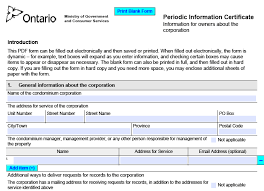 March 2024
March 2024
The Condominium Act requires Ontario condominiums to regularly send a Periodic Information Certificate (PIC) to owners, within 60 days after the end of the first and third quarter of the condominium corporation’s fiscal year. This semi-annual reporting certificate became a legal requirement in 2018, following major reforms to the Act in 2017.
The PIC was introduced to increase communication between condominium boards and unit owners. The Condominium Authority of Ontario (CAO) has set out specific form and requirements for the PIC to ensure owners are continually kept apprised of financial, legal, and other matters that are the responsibility of the property manager along with the board of directors. Effectively, it’s a regular, structured snapshot of the financial health and governance of their corporation.
Despite being in place for over five years, PICs are often only provided with a cursory effort. They are commonly relegated to the bookkeeping department of the property management company to complete, with insufficient scrutiny by the board or condominium managers – viewed by some just as a semi-annual nuisance form to be filed.
However, according to the Act, PICs are part of the corporation’s core records and fundamental to the ongoing daily operation of the condominium. The corporation is responsible for the preparation and accuracy of the PIC. If it fails to comply with this obligation, it could potentially face applications for compliance orders from unit owners and penalties from the Condominium Authority Tribunal (CAT).
Despite its value and importance, the PIC is a poorly designed form. Some of the questions are vague (e.g. what constitutes the “annual contribution to be made to the reserve fund” for Section 4, page 5 of the form), leaving too much leeway in its preparation, and doesn’t require specific disclosure of special assessments nor anticipated significant capital expenditures (e.g. same section goes on to require listing “the anticipated expenditures to be made from the reserve fund in the current fiscal year…” – yet most major projects span multiple years).
Echoing a July 2023 Toronto Condo News article, “the PIC is of little value in understanding the financial state of your condominium corporation.”
It’s time to remedy this and empower condominium owners with relevant, accurate information.
To do so, I call on:
- The CAO to review and update the PIC form, as well as providing condominiums with guidelines on completing these forms (and if needed, add regulations).
- Directors to scrutinize their semi-annual PIC forms – while clearly the responsibility for preparing PICs resides with the condominium manager, the ultimate responsibility lies with the board and the absence thereof puts the corporation at risk (boards need to implement a more structured review and approval process of their PIC filings).
Bruce Young, CPA, CA, CEA is an advisor and founder of Collective Agreement . He applies a pragmatic, strategic perspective to help those dealing with disputes and matters prone to litigation optimize outcomes. Toronto Condo News thanks Bruce for his assistance with this article.







